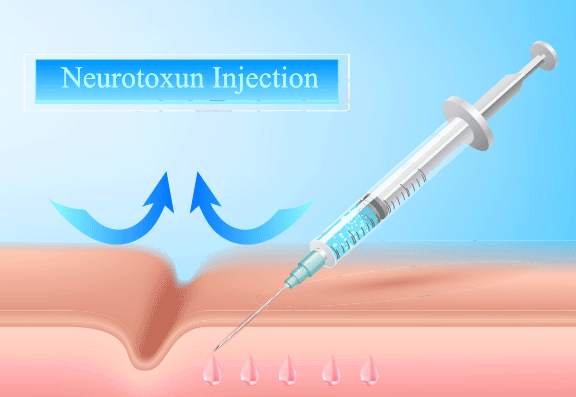A New Perspective on Botox
The pursuit of beauty and self-improvement is a timeless endeavour, yet the approaches to achieving such goals evolve. Enter Botox, a name synonymous with aesthetic enhancement and skin revitalisation but often shrouded in misconceptions.
This essential guide is crafted for those considering Botox for the first time, aiming to illuminate its benefits, debunk myths, and offer a comprehensive understanding of what to expect.
Understanding Botox: Beyond the Surface
Botox, scientifically known as botulinum toxin type A, has a rich history extending beyond cosmetic applications. Brands of botulinum toxin that are licensed include: Botox®, Bocouture®, Xeomin®, Azzalure®, and Dysport®.
Initially used for medical conditions, Botox’s potential to smooth out facial fine lines and wrinkles was a serendipitous discovery that has since revolutionised aesthetic medicine. Botox works by temporarily relaxing specific muscles, leading to a reduction in the appearance of wrinkles, offering a refreshed look that retains natural facial expressions when administered correctly.

What Are the Common Myths About Botox, and What’s the Truth?
- The ‘Frozen’ Face Fallacy:It’s a common misconception that Botox leads to an inability to express emotions. However, when administered by a licensed professional, Botox is precisely targeted to relax only the muscles that cause wrinkles, not all facial muscles. This selective approach preserves natural facial expressions while smoothing unwanted lines. It’s about enhancing your features, not erasing your expressions.
- Instant and Permanent Solution Misconception: Many believe that Botox effects are instantaneous and last forever. The reality is that the full effects of Botox typically become noticeable within a few days to two weeks after treatment, not immediately. While Botox can significantly reduce the appearance of wrinkles, the results are temporary, usually lasting three to six months. This duration can vary based on individual metabolic rates, the area treated, and the amount of Botox used. Regular maintenance sessions are necessary to sustain the desired effects.
- Botox is Only for Wrinkles: While Botox is famous for its aesthetic benefits, its applications extend far beyond wrinkle reduction. Botox is approved for various medical conditions, including chronic migraines, which it can help by relaxing muscles that contribute to the onset of headaches. It’s also effective in treating excessive sweating (hyperhidrosis) by blocking the nerves that activate sweat glands. The diverse uses highlight Botox’s therapeutic potential beyond cosmetic enhancements.
Which Areas Can Botox Treat?
Botox’s versatility extends to various facial areas, most notably the forehead, crow’s feet, and the space between the eyebrows. Additionally, its application in lower face areas includes treating a gummy smile, softening a popply (or dimply) chin appearance, reducing the visibility of platysma neck bands and addressing jowls, further showcasing its broad utility in enhancing facial aesthetics.
The wrinkle-relaxing treatments help soften age-related lines, enhancing natural beauty without altering fundamental expressions. Understanding the potential and limitations of Botox in each area can guide expectations towards realistic and satisfying outcomes.

How Do You Choose the Right Practitioner for Your Botox Treatment?
The significance of choosing a qualified practitioner cannot be overstated.
A successful Botox treatment begins with a comprehensive consultation, where your needs are discussed, and a personalised plan is formulated.
A reputable practitioner not only evaluates if you’re an ideal candidate but also ensures your treatment is conducted with the highest standards of safety and professionalism.
How Safe Is Botox for Aesthetic and Medical Treatments?
It’s crucial to choose an accredited practitioner and a qualified prescriber to ensure your procedure adheres to legal standards.
Resources like Save Face (The UK’s No.1 Government Approved Register for Medical Aesthetic Treatments) offer a directory to help you find the right professional.
Additionally, this video from the BBC’s ‘Con or Cure’ segment on patient Amy’s experience with an unlicensed practitioner underscores the risks of not doing so https://www.saveface.co.uk/en/blog/post/bbc-con-or-cure.
How Safe Is Botox for Aesthetic and Medical Treatments?
When considering Botox for both aesthetic and medical purposes, understanding its safety and efficacy are paramount. Educating yourself on the procedure, aftercare, and the importance of following professional advice maximises treatment efficacy and patient satisfaction.
Botox has a robust safety record, backed by extensive clinical research and regulatory approvals for various treatments. However, like all medical procedures, it carries potential side effects - most commonly, minor bruising or discomfort at the injection site. Rarely, more significant effects can occur, underscoring the importance of choosing a qualified practitioner.
Pre-treatment consultations are essential to assess individual risks and benefits, ensuring treatments are tailored to each patient’s needs. Informed aftercare, as advised by healthcare professionals, further optimises outcomes and minimises complications, making informed patient decisions critical for maximising treatment safety and satisfaction.
How Can You Prolong the Results of Your Botox Treatment?
Proper post-treatment care is essential in maximising the benefits of your Botox treatment and maintaining your refreshed appearance. Here are our refined tips for post-treatment care:
- Avoid rubbing or massaging the treated areas for at least 24 hours.
- Drinking plenty of water and taking paracetamol can help alleviate any post-treatment headache.
- Stay upright and avoid lying down for 4 hours after the procedure.
- Refrain from strenuous activities or exercise for 24 hours post-treatment.
- Follow any specific aftercare instructions provided by your practitioner tailored to your treatment plan.
Following these tips will help to maintain the effectiveness of the Botox treatment and extend the refreshed appearance.

Author: Clare McLoughlin
Clare McLoughlin has been a general nurse since 1988 and is an Independent Nurse Prescriber and advanced procedure aesthetic nurse and trainer with more than 16 years’ experience in the aesthetic field.Clare is a member of the Save Face UK Expert Advisory Board.
As a recognised aesthetic trainer, Clare is known for her professional approach and skill in the field of aesthetics and has appeared on a number of television programmes performing injectable aesthetic treatments. After working as a practitioner for a large national chain 2001-2003, Clare started her own business – Appearance Based Medicine – in 2004, to enable her to provide the highest level of patient care and satisfaction.
Clare is has been an advanced techniques trainer in Botulinum toxin treatments and Skin fillers since 2004. As well as training other Healthcare professionals in this field, Clare is a member of the British Association of Cosmetic Nurses (BACN) and British Association of Sclerotherapists (BAS).
Clare is recently published and her clinic Appearance Based Medicine is located in Marlow- on- Thames.
To view more blogs by Clare McLoughlin please click here.
